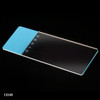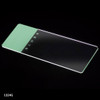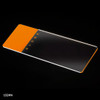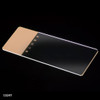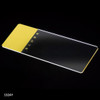Globe Scientific
Color Coded Classic Microscope Slides with Safety Corners
- Availability:
- Ships within 1-2 business days if ordered by 3pm EST.
- Shipping:
- Calculated at Checkout
Description
Color Coded Classic Microscope Slides with Safety Corners
Availability:
Ships within 1-2 business days if ordered by 3pm EST.
Globe's color frosted microscope slides are offered in ten bright, attractive colors. They are available in three edge styles: ground, ground with safety corners or beveled. The ground edge microscope slide offers 90° corners and is perfect for use in automatic cover slip machines. The ground edge microscope slide with safety corners provide slightly clipped corners for comfortable handling and to prevent the risk of finger and hand cuts. The beveled edge microscope slide is ideal for performing blood smears. The highly polished edges are specially angled at 45° to provide a secure grasp during the smearing process. All microscope slides are printed with "Globe" under the frosting area for orientation purposes. They are pre-cleaned and ready to use.
- Dimensions: 25 x 75 x 1mm
- Thickness: 1.1 mm
- Color Frosted one end, one side
- Packaging: 72/Box, 20 Boxes/Case (10 Gross)
Transportation and storage conditions considerably affect the quality and performance of microscope slides. Microscope slides should be stored in a dry place at constant room temperature. Slides should be stored on a pallet or shelf and not directly on a floor. Do not store slides and solvents together as the slide surface can turn hydrophobic. If the temperature is constantly warming and cooling, condensation may occur, which can cause sticking of the slides. Slides should be allowed to reach room temperature prior to use.
Since soda lime glass is subject to an aging process, we further recommend continuously rotating stock so the oldest slides are always used first. This will ensure that all slides being used are of the highest quality.
Standard shelf life for soda lime glass microscope slides is approximately 2 years if the above transportation and storage conditions are followed.
Globe Scientific Color-coded microscope slides are specialized tools used in various scientific and medical fields to facilitate the identification and categorization of specimens under a microscope. These Globe slides are an essential component of laboratory work, allowing researchers, pathologists, and technicians to quickly and accurately analyze and study samples.
The color-coded system assigns specific colors to different types of specimens, making it easier to identify and organize them during microscopic examination. Each color represents a particular category, such as cells, tissues, microorganisms, or stains, and serves as a visual cue that helps streamline the laboratory workflow and enhance efficiency.
There are several benefits to using color-coded microscope slides:
Improved organization: By assigning different colors to various specimen types, color-coded slides aid in the systematic arrangement of samples. This organization ensures that specimens are easily identifiable and readily accessible, reducing the chances of misplacement or confusion.
Quick identification: Color-coding enables researchers and technicians to swiftly recognize and differentiate between different types of specimens. This feature is particularly valuable when working with large volumes of samples or when time is of the essence, such as in emergency medical settings.
Streamlined workflows: With color-coded slides, laboratory personnel can easily sort and prioritize samples based on their specific color. This simplifies the process of preparing slides, reduces the chances of errors, and allows for faster data collection and analysis.
Standardization: Color-coded microscope slides facilitate standardization in laboratory protocols. By using a universally recognized color system, different laboratories can communicate and collaborate more effectively, ensuring consistency and accuracy in specimen identification.
The specific color-coding scheme may vary depending on the institution or laboratory. However, there are some commonly used conventions:
Blue Slides: Often used for general staining or mounting media.
Pink Slides: Frequently used for human or mammalian tissues.
Green Slides: Commonly employed for staining plant tissues or botanical samples.
Yellow Slides: Sometimes used for microorganisms or biological stains.
Clear or white Slides: Often utilized for unstained or lightly stained specimens.
Red Slides: Occasionally used for special stains or specific types of cells.
It's important to note that while color-coding can enhance efficiency and organization, it should not replace proper labeling and documentation. Accurate record-keeping and detailed information about each specimen are essential for research integrity and reproducibility.
In conclusion, color-coded microscope slides from Globe Scientific are valuable tools in the field of microscopy. By assigning different colors to various specimen types, these slides aid in organizing, identifying, and prioritizing samples. They contribute to streamlined workflows, improved efficiency, and enhanced collaboration among researchers, pathologists, and laboratory personnel.












